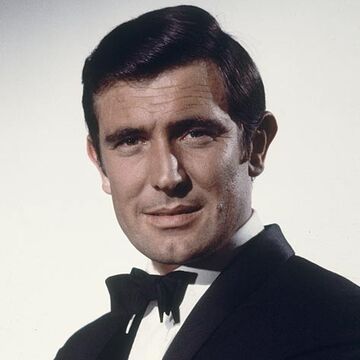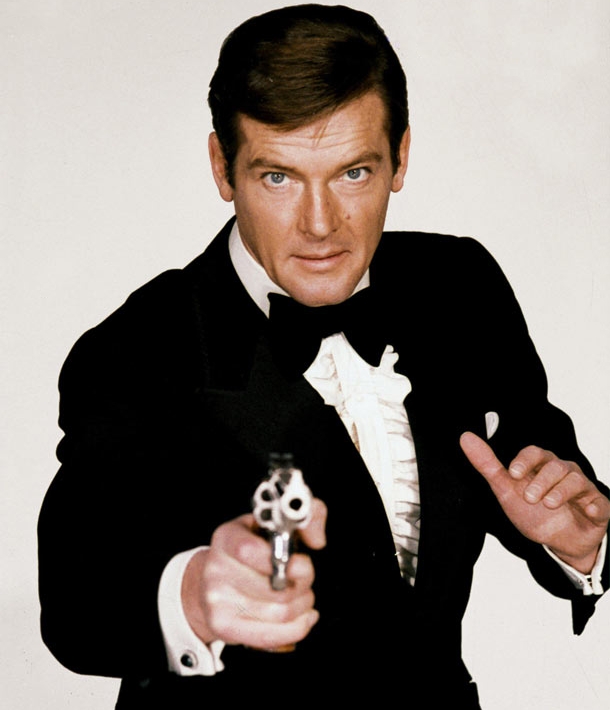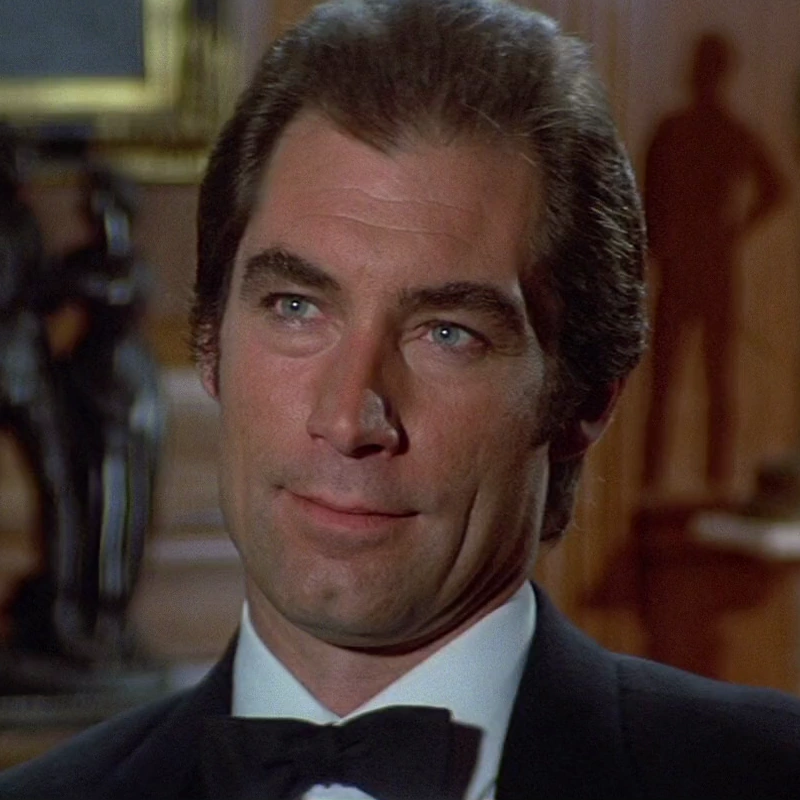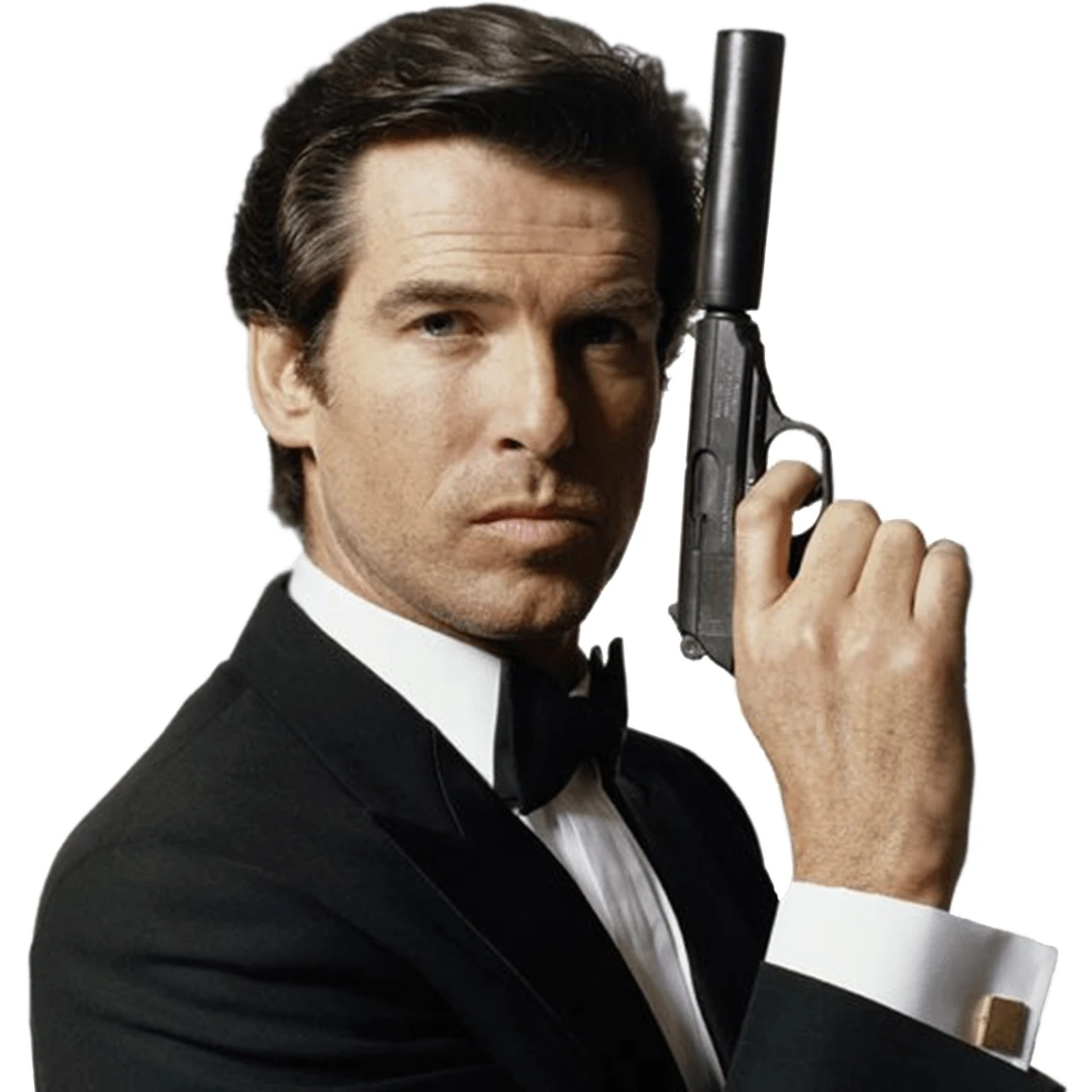- Andy E. Nystrom
- One Above All (Adminstrator)
 Offline
Offline 
- From: Victoria, BC
- Registered: 1/03/2020
- Posts: 6,960
James Bond as Code Name: The Evidence For and Against
This was something I started on in Capes (Optional) in 2015, but only got as far as Goldfinger. Since people on these boards seem interested in continuity, I thought it might be a nice fit here, despite the minimal ties between Bond and Marvel. I’ve expanded this to Diamonds are Forever, and will continue the analysis through to SPECTRE, and eventually No Time to See the Sequel Due to the Virus.
A popular theory out there is that in the official movies, not only 007 but even the name James Bond are code names for various secret agents as they are killed or incapacitated, or simply leave MI6/Her Majesty’s Secret Service. This series looks at the evidence from the various Eon Productions movies.
First off, a word about five key non-canonical Bond series and why they aren’t examined more closely. First off the big reason is they’re not part of the official series. Beyond that: The Casino Royale episode of Climax! treated Bond as an American secret agent. The original Casino Royale big screen movie, while it fits in nicely with the pro-code name side is a comedy that isn’t easily integrated into the core series, especially the ending. Never Say Never Again, while featuring former Bond Sean Connery, is a remake of Thunderball. The cartoon series James Bond Jr. focuses on his nephew and not on Bond himself. And the GoldenEye TV movie is set in a pseudo real world where Bond is an ornithologist, not a spy.
Proponents of this theory believe that every time a new actor is cast as Bond, it’s a different character. If casting is that important an element to the theory, I think it’s also worth looking at all instances where an actor has been recast, not just Bond himself. However, to avoid getting into minutiae and derailing the analysis, voice actors dubbing multiple characters will not be examined.
Dr. No (1962)
Casting:
For this movie there are six recurring characters (in one case just barely so): James Bond (Sean Connery), CIA agent Felix Leiter (Jack Lord), Bond’s boss M (Bernard Lee), Bond’s would be girlfriend Sylvia Trench (Eunice Gayson, voices by Nikki Van der Zyl), M’s secretary Miss Moneypenny (Lois Maxwell), and Bond’s equipment source (though not the gadgeteer he would later become) Major Boothroyd (Peter Burton). As this is the first appearance of all in the Eon series, there is no actor switch to consider at this early stage.
Other Evidence:
Bond right from his first scene throws out the name James Bond. As he does throughout the series, he is already pretty free with using this name publicly given his profession. Given that this is more or less a constant, it will not be examined further unless there is new information to examine.
The James Bond as code name theory raises the issue of why whoever is using the James Bond code name also consistently used then 007 code name and vice versa. Again, both names are used throughout the series so this also won’t be discussed unless there is new information.
Bond continues to use the name James Bond even when not in the field. While the obvious implication is that Bond therefore is his real name, it could also be the case that MI6 is particularly tight with security. Once again he is referred to as both Bond and 007 throughout the series during mission briefings.
From Russia with Love (1963)
Casting:
The characters mentioned above reappear except Leiter (though he returns later). However, Sylvia, again played by Gayson/Van der Zyl disappears from the movies after this movie. Therefore, while not a bad character, she’s of no consequence to this particular debate. Connery, Lee, Maxwell also reprise their roles. While Dr. No is referenced, he does not actually appear.
Two new recurring characters debuts here: an as yet identified man (played by Anthony Dawson and voiced by Eric Pohlmann) stroking a white cat, and the cat itself. Casting information on the cat is not readily available and for the most part thus will not be examined in this series except in reference to the character below. It is probable however that many cats were used in the series.
Anthony Dawson is an interesting case as he played a different character in the first Bond movie. Normally the logical extreme conclusion of the James Bond as code name theory would be that different characters played by the same actor are in fact the same person. However, since Dawson is only partly seen, we can make allowances as we would for stunt doubles.
Desmond Llewellyn becomes the first instance of a character being recast, taking over from Peter Burton. While he would be known as Q in most of his appearances, in this film he is referred to as Major Boothroyd as per the first film. So if James Bond is a code name, it stands to reason that Major Boothroyd is also a second code name. This raises the question as to why someone who is rarely in the field (Boothroyd being the man who equips Bond with vehicles and gadgets) would need two code names.
Goldfinger (1964)
Casting:
Connery, Lee, Maxwell, and Llewellyn all return, with Llewellyn now credited as Q, the code name of Major Boothroyd. Taking the Bond as code name theory to its extreme, this is the first time that Bond's gadget man took on a second code name. Llewellyn is known as Q here on in.
Cec Linder takes over as Felix Leiter, Bond’s main American ally from Jack Lord. Taking the Bond as code name theory to its logical conclusion suggests that Felix Leiter is also a code name. However, after Dr. No, Bond seems to have familiarity with one another. If Bond and Leiter are in fact code names, people taking on the two code names seem to have a fairly easy time striking up a friendship with one another.
Thunderball (1965)
Casting:
Connery, Lee, Maxwell, Llewellyn, and, after a movie’s absence, Dawson all return, the latter in his most recent role. This time Rik Van Nutter is Leiter. See Goldfinger above for my thoughts there.
You Only Live Twice (1967)
Casting:
Connery, Lee, Maxwell, and Llewellyn all return. The mysterious man with the cat is now revealed to be Ernst Stavro Blofeld. Now that he appears fully on screen, Donald Pleasence takes over the role. As noted above the casting change doesn’t necessarily provide evidence either way, as Dawson was basically a stand-in until the reveal.
On Her Majesty’s Secret Service (1969)
Casting:
Lee, Maxwell, and Llewellyn all return. George Lazenby takes over as Bond here, albeit for just one movie. At the start of the movie he breaks the fourth wall and remarks to the viewers, “This never happened to the other guy”. This is probably the strongest evidence in the pro-code name theory. However, there are potential alternate explanations: It could be seen as an aside and not a true part of the movie (more of an acknowledgement that in 1969 the cast change is a very big deal), or he could be referring to the other actor rather than the other character. Of course, if he is a separate Bond, it could be that he’s the only one with the power to detect the viewers.
Blofeld is now played by Telly Savalas. If Bond is a code name, Blofeld could also be a code name by whoever happens to be leading SPECTRE. Like the previous Blofeld, this Blofeld's sole redeeming factor seems to be a fondness for a white cat.
It is interesting that Bond and Blofeld act like they’ve never met before (going from memory the movie seems a bit non-committal here). This in a way supports the idea that both are code names, but from a continuity standpoint it’s a bit puzzling: if this is a new Bond, he should have at least been briefed about Blofeld and recognized the name, and Blofeld should have been aware that a James Bond thwarted SPECTRE’s previous scheme.
In addition, Moneypenny seems a bit sad about Bond getting married. Certainly it's possible to have feelings for more than one person at the same time or within a short timeframe, but it's still a point in the same person favour.
Diamonds are Forever (1971)
Casting:
Lee, Maxwell, and Llewellyn all return, as does Connery after a movie’s absence. If you believe that Bond is a code name, then it seems that either multiple agents can use the code name or that a former user of the name can pick it up again after it’s been abandoned by a successor. Leiter is now played by Norman Burton (see my thoughts under Goldfinger). Blofeld is now played by Charles Gray, and it seems clear that both of them know each other, which would suggest that Blofeld at the very least is the earlier character or that there was an unseen adventure in between. This Blofeld as well shared his predessors fondness of white cats should he be a different character.
Other Evidence:
Spoilers to the ending of On Her Majesty’s Secret Service:
At the start of this movie, Bond seems to have a vendetta against Blofeld. He is noticeably angrier than usual. While this could just be due to the events of You Only Live Twice, it makes even more sense for Bond to be that angry if Blofeld was responsible for the murder of Bond’s wife Tracy, as seen at the end of On Her Majesty’s Secret Service. Her murder is not mentioned overtly, and Bond seems calmer when he encounters Blofeld later, but it could be that at the start of the movie he got his rage out of his system. Here’s the sequence; brief breasts if that’s a concern:
In addition, Moneypenny is definitely attracted to Bond here. If the Lazenby Bond was another person she's gotten her sadness out of her system.
Live and Let Die (1973)
Casting:
Lee and Maxwell return (Q doesn't appear this movie). Bond is now played by Roger Moore. Moore's Bond does seem a bit warmer and less dangerous than other Bonds before or after, which is a point in the "different person" theory. He seems familiar with M and Moneypenny but that works more or less in either direction. Leiter also returns, this time played by David Hedison. Both versions of each characters seem familar with each other. If they are both using code names, then both must have worked at least one mission together off screen using those code names prior to their first onscreen appearance.
Other Evidence:
Moneypenny continues to seem attracted to Bond. If the Bonds are a different person, she seems to have a fetish for anyone using the James Bond code name. She remains attacted to Bond throughout the remainder of this era and thus this won't be noted futher.
The Man with the Golden Gun (1974)
Casting:
Moore, Lee, Maxwell, and (after a movie's absense) Llewellyn all return. Clifton James also returns as Live and Let Die's J.W. Pepper one last name. This time in terms of casting, there's no evidence one way or the other.
Other Evidence:
At the start of the movie, Scaramanga's lair has a dummy made to look like Moore's James Bond. If Moore's Bond is indeed a separate character, then he's racked up enough offscreen missions to attract the attention of a world class assassin. The Live and Let Die mission alone (actually one of Bond's more low key missions) probably won't have been enough to put this Bond so much on Scaramanga's radar that he'd create a dummy of him.
The Spy Who Loved Me (1977)
Casting:
Moore, Lee, Maxwell, and Llewellyn all return. This time in terms of casting, there's no evidence one way or the other. Walter Gotell makes his first appearance as Gogol, a non-villainous Russian general, and Geoffrey Keen makes his first appearance as the Minister of Defence, Sir Frederick Gray.
Other Evidence:
Spoilers to the ending of On Her Majesty’s Secret Service:
Moonraker (1979)As Anya Amasova summarizes Bond’s history, Bond cuts her off after she says “Wife killed...” While Moore’s Bond could simply be another spy whose wife was killed in action, the obvious implication is that it’s Tracy that Amasova is referring to. The scene:
Casting:
Moore, Lee, Maxwell, Llewellyn, Gotell, and Keen all return. Also, Richard Keil returns as Jaws from The Spy Who Loved Me one last time. Once again in terms of casting, there's no evidence one way or the other.
For Your Eyes Only (1981)
Casting:
Moore, Lee, Maxwell, Llewellyn, Gotell, and Keen.Lee passed away prior to filming his scenes and so the character of Bill Tanner (played by James Villiers) was created in his place for this particular movie. An unidentifed man played by John Hollis appears at the beginning of the movie, not explicitly named but heavily impiled to be Blofeld. If this is a dfferent Blofeld or a different character entirely, characters code named James Bond seem to attract a lot of villains who have a fondness for white cats.
Other Evidence:
Spoilers to the ending of On Her Majesty’s Secret Service:
At the start of the movie, Bond is visiting Tracy's grave, suggesting he at least knew her well enough to visit her grave. Since Tracy is part of a crime family, it's certainly possible that she encountered Moore's Bond prior to Lazenby's, but it's a reach. If she did, it's likely the encounter happened before Moore's character assumed the code name, as most people would remark if they met someone with an identical name to someone else they knew. In addition, the man with the white cat targets Bond there. This makes more sense if he's Blofeld and Bond is the same one from On Her Majesty's Secret Service: As Blofeld was responsible for Tracy's death, he would thus know that sooner or later Bond would visit Tracy's grave. If this is a different Bond, it's less intuitive to search for Bond here. It also would mean that the main with the white cat seen here had some offscreen reason for wanting to target this Bond specifically. Tracy’s grave also references the song We Have All the Time in the World from the movie, which was also dialogue in that movie. Here is the scene from this movie:
Octopussy (1983)
Casting:
Moore, Lee, Maxwell, Llewellyn, Gotell, and Keen all return. Robert Brown now takes over as M. Whether this is the same M as the previous movies or a different one is unclear; since this M's real name is never revealed, it probably doesn't matter. Maud Adams. who previously played Andrea Anders in The Man With the Golden Gun appears here as Octopussy. If a change in actor results in a change of character, then it would make sense that the reverse is also true: same actor, same character. But there are two problems here: One is that Bond and Octopussy don't recognize each other despite Bond being played by Moore in both movies. Secondly,
Andrea is murdered by Scaramanga in The Man With the Golden Gun. If she somehow got revived, perhaps by Baron Samedi from Live and Let Die, it might explain why she doesn't recognize Bond but not why he doesn't recognize her.
A View to a Kill (1985)
Casting:
Moore, Lee, Maxwell, Llewellyn, Gotell, and Keen all return. Adams also has a cameo, but it's so brief that it doesn't really matter if it's someone she played before or a new character. So again in terms of casting, there's no evidence one way or the other.
The Living Daylights (1987)
Casting:
Brown, Llewellyn, Gotell, Keen all return, though this is the final appearance in the Bond series of Gogol/Gotell and Gray/Keen. Timothy Dalton takes over as Bond while Caroline Bliss takes over as Moneypenny. Moneypenny doesn't seem quite as attracted to Bond as her predecessor, so if both Bond and Moneypenny are code names, the fact that Moneypenny seems not to pine for Bond quote as much makes sense. Also, as Loki notes, she could conceivably be the daughter of the original Moneypenny rather than a code name. This works either way, but if it’s the same Bond to this point, Moneypenny’s disinterest in Bond makes even more sense because, despite appearances to the contrary, he’s probably older than the earlier Moneypenny. If this is the case, given that Miss Moneypenny remained single, it would not be unreasonable for her to have the same surname as her mother.
Licence to Kill (1989)
Casting:
Dalton, Bliss, Brown, and Llewellyn all return. In addition, David Hedison who played Leiter in Live and Let Die, returns to the role one last time. Given that Bond is invited to Leiter’s wedding as his best man, it’s easier to believe that these are the same Bond and Leiter who have known each other for a very long time than if this Leiter only knew this Bond offscreen up to this point. In addition, there is no reason to believe that Leiter is using a code name to his own wedding.
Other Evidence:
Spoilers to the ending of On Her Majesty’s Secret Service:
When Leiter’s bride Della Churchill suggests that Bond will get married at some point, there’s an awkward moment and Leiter explains that Bond was married once. While this could be a Bond who was widowed/divorced offscreen, the scene has more of an emotional impact to it if Leiter is referring specifically to Tracy. Here is the scene:
GoldenEye (1995)
Casting:
Llewellyn returns as Q but otherwise it’s an all new cast. Pierce Brosnan takes over as Bond, Judi Dench as M, and, ironically, Samantha Bond as Moneypenny. Michael Kitchen takes over as Bill Tanner, whose only previous appearance was in For Your Eyes Only. M is unquestionably a different character than before, regardless of whether there was one or two previous M’s. See The Living Daylights for the various possibilities with Moneypenny. If this Moneypenny is a second daughter, then the first Moneypenny must have led a more interesting life than was originally apparent. Since Bill Tanner is not a field agent, having that name be a code name is a bit unusual but not out of the question. Recurring character Jack Wade (another CIA agent) is also introduced here, played by Joe Don Baker. If you believe that Bond is a code name and so is Leiter, it’s possibly that the CIA gave Bond a contact using a different code name, considering the Felix Leiter name to be too compromised after multiple encounters with multiple Bonds. If Bond and Leiter are not code names, it makes sense that Leiter would have retired after the events of Licence to Kill.
Other Evidence:
Spoilers to the ending of On Her Majesty’s Secret Service:
At one point, Alec Trevelyan taunts Bond, asking him if he’s “found forgiveness in the arms of all those willing women for the dead ones you failed to protect?” This noticeably makes Bond uncomfortable, and works best if he’s thinking of Tracy (as well as the various other non-villain women who have died because they met Bond), than if he’s a new character who has lost female companions on offscreen missions. 4 1/2 minutes into this video:
Tomorrow Never Dies (1997)
Casting:
Brosnan, Dench, Bond, and Llewellyn all return, as does Baker for the second and last time. This time in terms of casting, there's no evidence one way or the other.
The World is Not Enough (1999)
Casting:
Brosnan, Dench, Bond, and Llewellyn all return, as does, after a movie’s absence, Kitchen for the second and last time. Again, in terms of casting, there's no evidence one way or the other, though the casting of John Cleese as R leads to a footnote in Die Another Day.
Die Another Day (2002)
Casting:
Brosnan, Dench, Bond, and Llewellyn all return. John Cleese plays Q in this movie. Since Q announced his retirement in The World is Not Enough, it is likely that this Q is the R seen in the previous movie. However, this has no real bearing on the Bond as code name theory nor does anything else casting-wise.
Other Evidence:
Bond sees the jetpack from You Only Live Twice and asks, “Does this thing still work?” Obviously this could be a younger Bond who was briefed on the Connery Bond’s past adventures, but the scene does suggest that Bond is recalling using this in the earlier movie.
Special Note: As will be delved into more detail with the next movie, for people who subscribe to the theory that Bond is not a code name, this is the final appearance to date of the version of Bond who first appeared in Dr. No.
Casino Royale (2006)
Casting:
Dench returns as M. Daniel Craig is now Bond and Jeffrey Wright is now Leiter. Whichever theory you subscribe to, this is a new incarnation of Bond. There is no way to reconcile this movie with earlier movies, since Bond is shown here to be at the start of his career, and yet M resembles the one from the most recent movies. For people who subscribe to the Bond as code name theory, this M is in fact the same one as the previous movies. For people who disagree with that theory, this is the start of a brand new continuity that continues to the present and thus M is a different character who happens to be played by the same actress. Either way, her relationship with the Craig Bond is different than with the Brosnan Bond. With the Brosnan Bond, M was rather cold, while with the Craig Bond she is more motherly, just as, particularly in the Brosnan era, Q became increasingly fatherly (though more of a curmudgeon than M). This being the case, depending on which theory you believe, either the CIA has once again started using people with the Leiter code name to liaison with Bond or this is the first appearance of the sole Leiter of the new continuity.
In addition to the above, Mr. White, a minor villain (in this movie) representing Quantum is introduced here. He is also a recurring character in the modern era and is played by Jesper Christensen
Other Evidence:
Starting here, the movies become more tight with continuity, with each subsequent movie (except Skyfall) making direct reference to the previous movies, whereas previous movie, with rare exceptions, were more subtle in referencing earlier movies. This does lend itself to the feeling that this is a brand new series and not the world of the previous movies.
Quantum of Solace (2008)
Casting:
Craig, Dench, Wright, and, in a larger role, Christensen all return here. A key character from Casino Royale, Vesper Lynd (played by Eva Green) also reappears, but only in archive footage related to the previous movie. Rory Kinnear takes over as Bill Tanner, so if you’re pro-code name, this is the latest Tanner; otherwise this is the Tanner of the new continuity.
Other Evidence:
As previously noted, the events of the previous movie are noted. However, until someone else replaces Craig as Bond, we won’t know how if at all movies with subsequent Bonds make use of this continuity.
Skyfall (2012)
Casting:
Craig, Dench, and Kinnear return here. New character Gareth Mallory is introduced here, played by Ralph Fiennes.
We are also introduced to a new Q, played by Ben Whishaw. Bond figures out in mid-conversation that he must be Q, suggesting he is familiar with Q being a series of operatives of which the Whislaw version is the latest; this still works with either theory though it does to a slight degree work better with the Bond as code name theory. Naomie Harris appears as Eve Moneypenny. This could be another code name or another daughter (or granddaughter, still using the same surname) as the earlier Moneypenny, but her being the new Moneypenny of the new continuity is probably the simplest explanation.After M dies, Mallory takes over as the new M, the first, and only to date, overt case of a code name transferring from one character to another.
Other Evidence:
A key character in this movie is Kincaide, played by Albert Finney. Kincaide actual knew bond in Bond’s youth, and only seems to know him as Bond. For the most part, this really only makes sense if this is a Bond of a new continuity and not the latest in the use of Bond is code name. The only other possible explanation is that the latest person to take on the James Bond code name happened to actually be named James Bond.
SPECTRE (2015)
Casting:
Craig, Kinnear, Fiennes, Whishaw, Harris, and, after a movie’s absence Christensen all return here, with Mr. White no longer a villain but definitely the same character.
This movie features the first appearance of Léa Seydoux as Madeleine, arguably the first true romantic interest to appear in more than one movie (any interest the Loix Maxwell version of Moneypenny had was purely one sided, While Sylvia Trench never went beyond "had potential".Dench also returns in a recording.
Christoph Waltz is also introduced as a mysterious figure from Bond’s past;
he is revealed to be Blofeld. Bond seems unaware of any previous Blofelds; if this was the previously continuity he likely would have known of past Blofelds and been shocked that one had a personal connection to him. In addition, as with Kincaide in the previous movie, Blofeld seems to know him solely as Bond despite knowing him in his youth. Blofeld’s white cat is obviously a new character; the white cat(s) seen previously, if they survived clashes with Bond would be dead of old age by now.
Other Evidence:
Some evidence, such as the numerous references to the previous three movies, will not be clear where they land until someone else takes over as Bond after No Time to Die. However, SPECTRE is depicted as landing on MI6 and thus Bond’s radar for the first time. If this was still part of the previous continuity, with multiple Bonds, it’s unlikely that Bond would not have heard of SPECTRE and even less likely that no one else would have heard of SPECTRE.
No Time to Die (2021)
Casting:
Craig, Kinnear, Fiennes, Whishaw, Harris, Waltz, Seydoux, and, after a two-movie absense, Wright all return in their respective roles. No new legacy characters are introduced. This movie in isolation doesn't provide any casting related evidence, but as this is the final outing of Daniel Craig as Bond, the use of any of the above actors will of course factor into any such discussion.
Major Spoilers:
Other Evidence:This version of James Bond actually dies at the end of the movie, so if this continuity appears again in any context, it will obviously provide new evidence for or against the James Bond as code name theory. New characters Nomi and Paloma could certainly appear in new movies set in a world where Bond is dead should Eon wish to revisit this continuity without negating the movie's ending Bond's death by itself isn't evidence either way; the next movie could be a fresh use of the code name or be set in a brand hnew continuity. It'll be the use or lack thereof of actors from Daniel Craig era movies that detremine the implications for this theory
Continuing from the above spoiler:
So future movies will determine if and how this movie is evidence either way.The use of the song We Have All the Time in the World from On Her Majesty's Secret Service is a clever combination of misdirect and forehadowing but it probably falls short of being evidence either way.
CONCLUSION
If you’ve read all of what I’ve written, you can probably guess what my position is: there is some evidence to support the James Bond as code name theory, but far more evidence to support the idea that there are two distinct, and separate continuities, with the Bond from Dr. No to Die Another Day all being one person in the original Eon continuity, and the Craig being the sole actor to date to play Bond in the modern Eon continuity. Either way you have to stretch things somewhat, and for the not code name theory there’s the matter of Bond getting deaged from time to time in the first era. But you have to do far more mental gymnastics in order to make the Bond as code name theory work once all the evidence is laid out, particularly due to one key event in the old continuity and people knowing Bond during his youth in the new continuity.
I must admit that I violated scientific principles a bit in that I knew what my conclusion would be even before I embarked on this, but I hope that if you do (or did) subscribe to the Bond as code name theory, you feel that I did try to be fair and acknowledge evidence in that theory’s favour whether I found it. While I did (and do) disagree with that theory, I did want to acknowledge why people might feel otherwise and not dismiss the other perspective out of hand.
Last edited by Andy E. Nystrom (12/09/2022 8:53 am)
- Andy E. Nystrom
- One Above All (Adminstrator)
 Offline
Offline 
- From: Victoria, BC
- Registered: 1/03/2020
- Posts: 6,960
Re: James Bond as Code Name: The Evidence For and Against






Last edited by Andy E. Nystrom (11/12/2020 10:28 pm)
- •
- Loki
- Moderator
 Offline
Offline - Registered: 1/03/2020
- Posts: 11,705
Re: James Bond as Code Name: The Evidence For and Against
While I appreciate that you are only part way through your analysis, and am interested to see the rest, I'm going to throw my thoughts out now anyway.
I'm very much of the "Bond is his name, 007 his codename." As you noted, in Diamonds Are Forever
To me, that one thread is enough to confirm all those movies feature the same character, not a string of men using the same codename.Connery's Bond starts by pursuing a vendetta against Blofeld for the murder of Teresa, Lazenby Bond's wife. That makes little sense if he's not the same man. Likewise, in The Spy Who Loved Me, Moore's Bond is noted as being a widower - okay, not something that confirmed it's Teresa and not a different wife of a different man, but circumstantial evidence. But then in For Your Eyes Only, Moore's Bond visits Teresa's grave - why would he do that if he's a different man? And there is confirmation that Dalton's Bond is a widower in License to Kill, and hints of it in Goldeneye.
Add in the
props scene in Die Another Day, where gadgets from the previous movies are shown and Bond clearly seems to recognise them, something he couldn't do if they had been used by other men who just had the same codename.
- Andy E. Nystrom
- One Above All (Adminstrator)
 Offline
Offline 
- From: Victoria, BC
- Registered: 1/03/2020
- Posts: 6,960
Re: James Bond as Code Name: The Evidence For and Against
I won't say which position I favour just yet as I want to seem as objective as possible when writing these. I do have a strong leaning in one particular direction, but I I want to be as fair as I can to the other point of view.
- •
- Andy E. Nystrom
- One Above All (Adminstrator)
 Offline
Offline 
- From: Victoria, BC
- Registered: 1/03/2020
- Posts: 6,960
Re: James Bond as Code Name: The Evidence For and Against
Added Moneypenny notes to OHMSS and DAF and updated to Man With the Golden Gun.
- •
- Andy E. Nystrom
- One Above All (Adminstrator)
 Offline
Offline 
- From: Victoria, BC
- Registered: 1/03/2020
- Posts: 6,960
Re: James Bond as Code Name: The Evidence For and Against
Revised some of the earlier posts (revised what I wrote on the white cat and added in notes on JW Pepper to TMWtGG) and nupdated to Living Daylights.
- •
- Loki
- Moderator
 Offline
Offline - Registered: 1/03/2020
- Posts: 11,705
Re: James Bond as Code Name: The Evidence For and Against
Andy E. Nystrom wrote:
Revised some of the earlier posts (revised what I wrote on the white cat and added in notes on JW Pepper to TMWtGG) and nupdated to Living Daylights.
It might be worth considering that Moneypenny in Living Daylights could be the daughter of the original - if we assumed that all the Bonds prior to Craig are the same man, just an increasingly well preserved one, then Living Daylights' Moneypenny not being so attracted to him makes sense - she puts up with his flirting because she recognizes it's not serious, but "ew, you're not only old enough to be my dad, but also my mum has a crush on you and you flirt with her too." It would be entirely feasible that she's followed her mother into the service in a similar role.
- Andy E. Nystrom
- One Above All (Adminstrator)
 Offline
Offline 
- From: Victoria, BC
- Registered: 1/03/2020
- Posts: 6,960
Re: James Bond as Code Name: The Evidence For and Against
Loki wrote:
Andy E. Nystrom wrote:
Revised some of the earlier posts (revised what I wrote on the white cat and added in notes on JW Pepper to TMWtGG) and nupdated to Living Daylights.
It might be worth considering that Moneypenny in Living Daylights could be the daughter of the original - if we assumed that all the Bonds prior to Craig are the same man, just an increasingly well preserved one, then Living Daylights' Moneypenny not being so attracted to him makes sense - she puts up with his flirting because she recognizes it's not serious, but "ew, you're not only old enough to be my dad, but also my mum has a crush on you and you flirt with her too." It would be entirely feasible that she's followed her mother into the service in a similar role.
I hadn't thought of that but it does make sense. And if Moneypenny had a daughter without being married (she's explicitly called Miss Moneypenny throughout the earlier movies), it's possible that Moneypenny is a surname for both of them and not a code name, since not all daughters of single moms have their father's surname. I'll add that in next update.
- •
- Andy E. Nystrom
- One Above All (Adminstrator)
 Offline
Offline 
- From: Victoria, BC
- Registered: 1/03/2020
- Posts: 6,960
Re: James Bond as Code Name: The Evidence For and Against
I've added to Dr. No and The Spy Who Loved Me through The Living Daylights. Note in particular the new Other Evidence section for The Spy Who Loved Me. I've also added Licence to Kill to Die Another Day.
- •
- Andy E. Nystrom
- One Above All (Adminstrator)
 Offline
Offline 
- From: Victoria, BC
- Registered: 1/03/2020
- Posts: 6,960
Re: James Bond as Code Name: The Evidence For and Against
Here is the scene I initially overlooked from The Spy Who Loved Me, with spoilers to On Her Majesty's Secret Service. It's some of Roger Moore's best acting.
- •
- Andy E. Nystrom
- One Above All (Adminstrator)
 Offline
Offline 
- From: Victoria, BC
- Registered: 1/03/2020
- Posts: 6,960
Re: James Bond as Code Name: The Evidence For and Against
Completed up to SPECTRE! If people have additional thoughts, I'll add them in, but otherwise, this is my entire examination on the subject for now, at least until the virus lets No Time To Die get released.
- •
- Andy E. Nystrom
- One Above All (Adminstrator)
 Offline
Offline 
- From: Victoria, BC
- Registered: 1/03/2020
- Posts: 6,960
Re: James Bond as Code Name: The Evidence For and Against
Added in video links to references in later movies to On Her Majesty's Secret Service.
- •
- Loki
- Moderator
 Offline
Offline - Registered: 1/03/2020
- Posts: 11,705
Re: James Bond as Code Name: The Evidence For and Against
Andy E. Nystrom wrote:
Either way you have to stretch things somewhat, and for the not code name theory there’s the matter of Bond getting deaged from time to time in the first era.
I used to think the same, or that we'd have to assume some level of sliding timescale so that the movies don't happen when they were released in cinemas, but more recently came to the conclusion that this isn't actually necessary. We do have to assume that we "squint" a little when we look at the actors to get round different people playing Bond and a few others, but Doctor No to Die Another Day could actually all work in a single continuity and with each film set at the time they were released. Here's how it could work:
M is a codename, and we see multiple Ms through the run. The M first seen in Octopussy was played by Robert Brown, who had previously appeared in The Spy Who Loved Me as Admiral Hargreaves, RN, so it's entirely reasonable to assume that Hargreaves has become the new M.
Q is likewise a codename, and we've seen two (maybe three). Since both Peter Burton and Robert Llewellyn were called Major Boothroyd, they probably were the same character (though it's not impossible that two siblings reached the same army rank and both joined Q Branch, it's somewhat of a stretch). John Cleese is an explicit replacement, having previously appeared as R.
We have two Miss Moneypennys, mother and daughter, as I suggested above.
One Blofeld, doing a lot of plastic surgery between movies - we got explicit confirmation he did this at least once, in Diamonds Are Forever, so no reason he couldn't have done it twice.
And as for Bond, once you "squint" to ignore the changing appearance with each new actor, the only real problem is his age. But hang on, let's assume that Bond in Doctor No (1962) is only in his early 20s (as opposed to Connery, who was early 30s at the time). That'd be a bit young to have achieved 00 status, but not impossible. Then in Die Another Day (2002), he'd be in his early 60s. Too old for his antics as depicted on screen?
Here's Tom Cruise, 56, filming Mission Impossible 7:
Jackie Chan, 66, in Vanguard (2020)
And there's plenty more where they came from - Keanu Reeves (56), Mark Dacascos (56), Donnie Yen (57), etc. All actors, true, but also ones who did most of their own stunts, and who are genuinely extremely fit and great fighters. And for those who might suggest, "yeah, but they don't take the kind of damage Bond would have over the years; that'd age someone" look again at Jackie Chan and his history of injuries. Despite breaking most of the bones in his body at one point or another, and having suffered some extremely severe injuries, he's managed to recover and continue undaunted.
So is it really impossible for Bond to have been an active agent from, say, 22 in 1962 until 62 in 2002?
- Andy E. Nystrom
- One Above All (Adminstrator)
 Offline
Offline 
- From: Victoria, BC
- Registered: 1/03/2020
- Posts: 6,960
Re: James Bond as Code Name: The Evidence For and Against
Good point, and that might explain why we stopped following Bond at 2002. After that point his health might have started to fail him enough to take him off the field due to all the punishment he put himself through (though I must admit I'd love to see that Bond return and see how he'd address the metoo movement; having someone as old has him having decades old values questioned would make for an interesting arc).
For that matter, the change in actors could, save for Lazenby, be the result of him having plastic surgery due to injuries and then notifying anyone who needed to know. Obviously the Lazenby case has to be chalked up to real world considerations as Connery resumed the rule after him, and for him to resume his old face with such precision would require extra explanations but the other instances could be explained away that way. Ditto Leiter; the single instance of his returning to an earlier face might have been him retiring and being allowed to return to a preferred look as a parting gift for his decades of service, and perhaps made him easier to be targeted.
Either way though, the Bond as code name theory falls apart if examined too closely.
- •
- Andy E. Nystrom
- One Above All (Adminstrator)
 Offline
Offline 
- From: Victoria, BC
- Registered: 1/03/2020
- Posts: 6,960
Re: James Bond as Code Name: The Evidence For and Against
I finally saw No Time to Die. The first post updated to reflect that, including adding a bit more to Spectre.
- •
 1 of 1
1 of 1